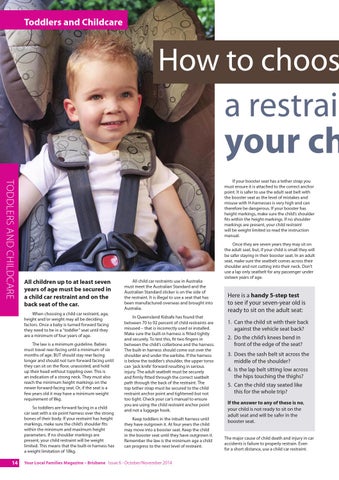Toddlers and Childcare
How to choos
a restrain
your ch TODDLERS AND CHILDCARE
If your booster seat has a tether strap you must ensure it is attached to the correct anchor point. It is safer to use the adult seat belt with the booster seat as the level of mistakes and misuse with H-harnesses is very high and can therefore be dangerous. If your booster has height markings, make sure the child’s shoulder fits within the height markings. If no shoulder markings are present, your child restraint will be weight limited so read the instruction manual.
All children up to at least seven years of age must be secured in a child car restraint and on the back seat of the car. When choosing a child car restraint, age, height and/or weight may all be deciding factors. Once a baby is turned forward facing they need to be in a “toddler” seat until they are a minimum of four years of age. The law is a minimum guideline. Babies must travel rear-facing until a minimum of six months of age. BUT should stay rear facing longer and should not turn forward facing until they can sit on the floor, unassisted, and hold up their head without toppling over. This is an indication of a strong neck. They must also reach the minimum height markings on the newer forward-facing seat. Or, if the seat is a few years old it may have a minimum weight requirement of 8kg. So toddlers are forward facing in a child car seat with a six point harness over the strong bones of their body. If your restraint has height markings, make sure the child’s shoulder fits within the minimum and maximum height parameters. If no shoulder markings are present, your child restraint will be weight limited. This means that the built-in harness has a weight limitation of 18kg.
14
All child car restraints use in Australia must meet the Australian Standard and the Australian Standard sticker is on the side of the restraint. It is illegal to use a seat that has been manufactured overseas and brought into Australia. In Queensland Kidsafe has found that between 70 to 92 percent of child restraints are misused – that is incorrectly used or installed. Make sure the built-in harness is fitted tightly and securely. To test this, fit two fingers in between the child’s collarbone and the harness. The built-in harness should come out over the shoulder and under the earlobe. If the harness is below the toddler’s shoulder, the upper torso can ‘jack knife’ forward resulting in serious injury. The adult seatbelt must be securely and firmly fitted through the correct seatbelt path through the back of the restraint. The top tether strap must be secured to the child restraint anchor point and tightened but not too tight. Check your car’s manual to ensure you are using the child restraint anchor point and not a luggage hook. Keep toddlers in the inbuilt harness until they have outgrown it. At four years the child may move into a booster seat. Keep the child in the booster seat until they have outgrown it. Remember the law is the minimum age a child can progress to the next level of restraint.
Your Local Families Magazine – Brisbane Issue 6 - October/November 2014
Once they are seven years they may sit on the adult seat, but, if your child is small they will be safer staying in their booster seat. In an adult seat, make sure the seatbelt comes across their shoulder and not cutting into their neck. Don’t use a lap only seatbelt for any passenger under sixteen years of age.
Here is a handy 5-step test to see if your seven-year old is ready to sit on the adult seat: 1. Can the child sit with their back against the vehicle seat back? 2. Do the child’s knees bend in front of the edge of the seat? 3. Does the sash belt sit across the middle of the shoulder? 4. Is the lap belt sitting low across the hips touching the thighs? 5. Can the child stay seated like this for the whole trip? If the answer to any of these is no, your child is not ready to sit on the adult seat and will be safer in the booster seat. The major cause of child death and injury in car accidents is failure to properly restrain. Even for a short distance, use a child car restraint.
